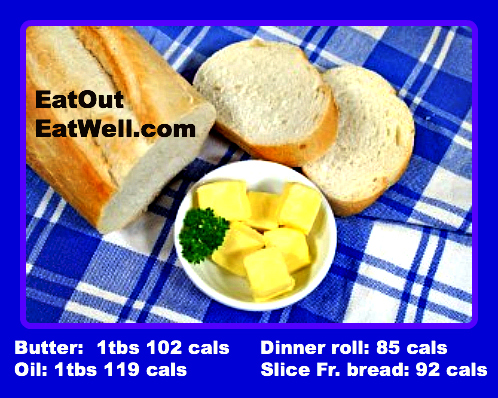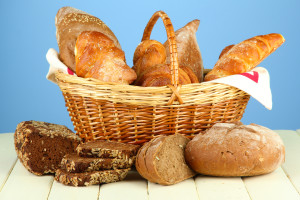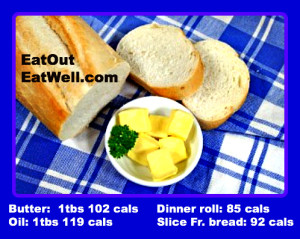
Have you been known to invade the breadbasket with gusto as soon as it lands on the table?
Then do you mindlessly continue to munch before and during your meal either because you’re hungry or because the bread is there for easy nibbling or for sopping up gravy or sauce?
Butter or Oil?
Olive oil for bread dipping is giving butter some stiff competition. Olive oil arrives green or golden, plain, herbed or spiced. It can be plopped down on your table, or poured with a flourish. Some restaurants offer a selection for dipping – and attempt to educate you about the variation in flavors depending upon the olives’ country of origin.
Butter can also appear in many forms. It still may still arrive in shiny foil packets – what would a diner be without them – or mounded in pretty dishes and sprinkled with sea salt or blended with various fruits or herbs.
Don’t be misled by the presentation — butter and oil, although delicious, are high calorie, high fat foods. Certain oils may be heart healthy, but they are still caloric.
Who Takes In More Calories – Butter Or Olive Oil Eaters?
Hidden cameras in Italian restaurants have shown that people who put olive oil on a piece of bread consume more fat and calories than if they use butter on their bread. But, the olive oil users end up eating fewer pieces of bread than the butter eaters.
In the study done by the food psychology laboratory at Cornell University, 341 restaurant goers were randomly given olive oil or blocks of butter with their bread. Following dinner, researchers calculated the amount of olive oil or butter and bread that was eaten.
The researchers found:
- Olive oil users used 26% more olive oil on each piece of bread compared to block butter users (40 vs. 33 calories).
- Olive oil users ate 23% less bread over the course of a meal than the people who used butter.
- Although the olive oil users used a heavier hand than the butter users for what they put on individual slices of bread, over the course of the meal they ate less bread and oil.
- Olive oil users took in 17% fewer bread calories: 264 calories (oil eaters) vs. 319 calories (butter eaters).
The Caloric Punch of Butter, Oil, And Bread
- A tablespoon of olive oil has 119 calories, a tablespoon of butter has 102 calories, one pat of butter has around 36 calories.
- Butter and oil are all fat; olive oil is loaded with heart healthy monounsaturated fat, butter contains heart unhealthy saturated fat.
- Bread varies significantly in calories depending on the type of bread and the size of the piece. Harder breads and breadsticks are often less caloric than softer doughy breads.
- Most white bread and a small piece of French bread average around 90 to 100 calories a slice. Dinner rolls average 85 calories each.
- If you’re eating Mexican food, bread may not appear, but a basket of chips adds around 500 calories.

